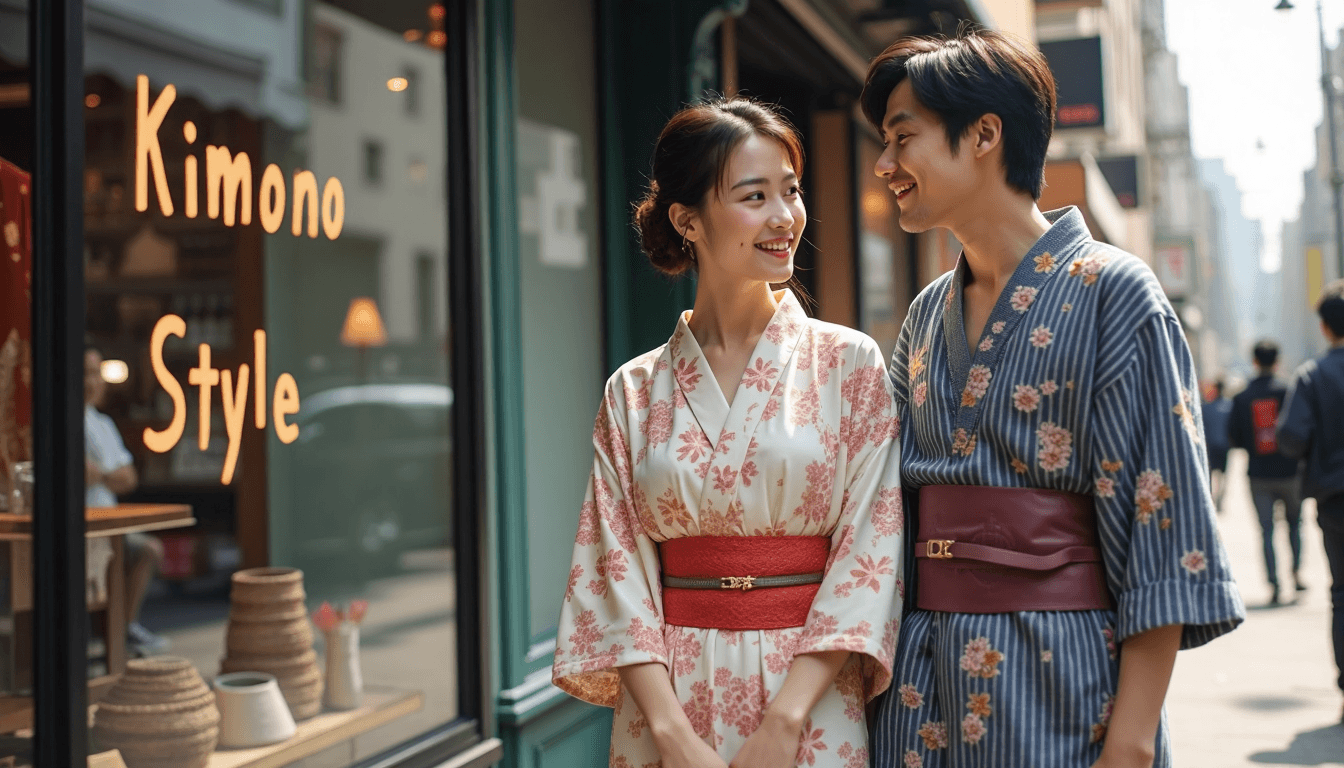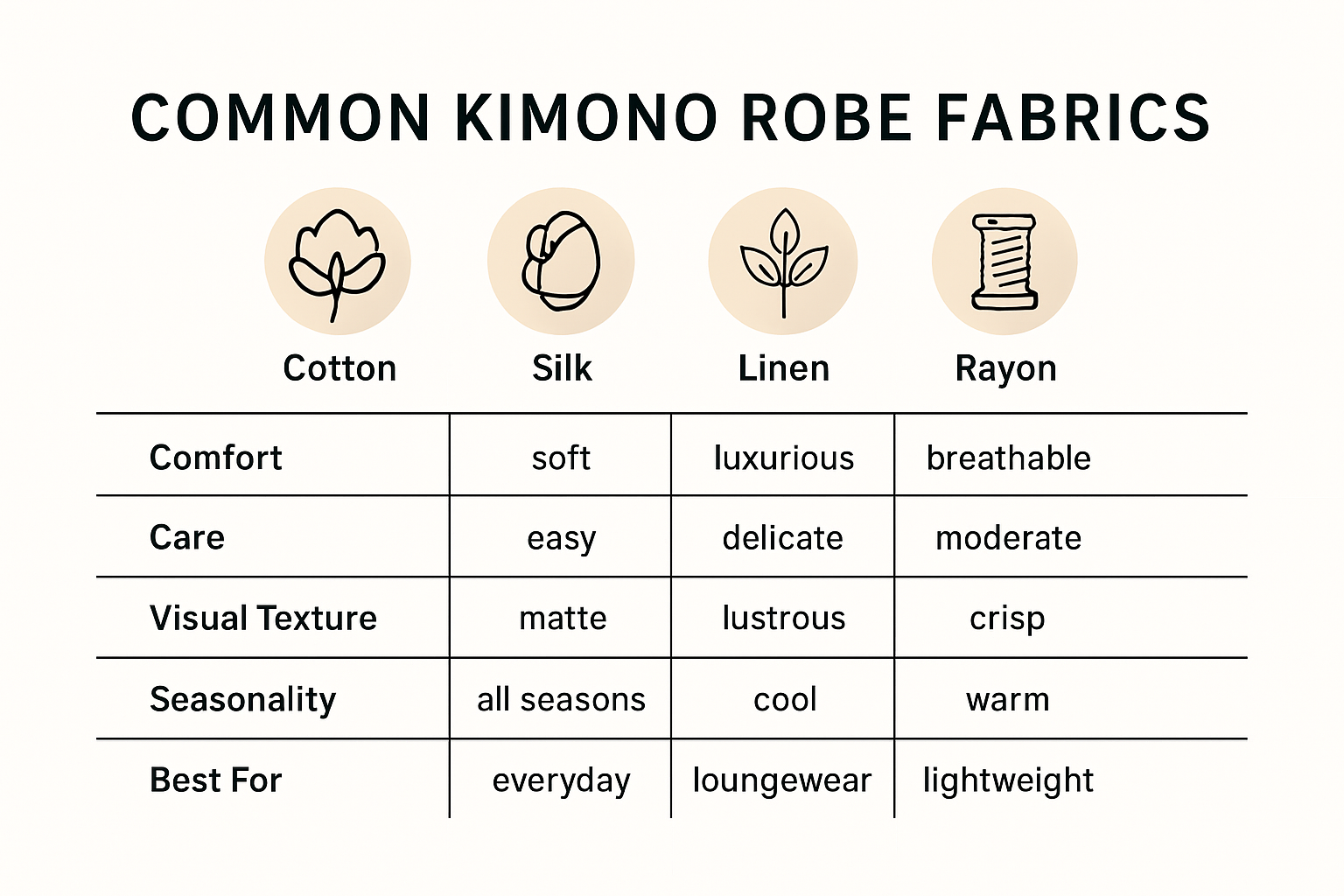
Kimono robes are showing up everywhere in fashion, from celebrity street style to TikTok tutorials. Talk about surprising, nearly 65 percent of first-time kimono buyers choose the wrong size or fabric for their needs. But here’s the catch. With a few smart tips, you can actually turn any kimono robe into your new go-to piece for every season and occasion.
Table of Contents
- Choosing The Perfect Kimono Robe
- Step-By-Step Guide To Wearing A Kimono Robe
- Creative Styling Ideas For Any Occasion
- Kimono Robe Care, Customization, And Gifting Tips
Quick Summary
| Takeaway | Explanation |
|---|---|
| Choose the Right Fabric | Select between cotton for comfort, silk for luxury, linen for heat, or rayon for affordability based on occasion and climate. |
| Understand Cultural Significance | Familiarize yourself with different kimono styles like Yukata for casual wear and Furisode for formal occasions to select appropriately. |
| Focus on Fit and Measurements | Ensure the kimono robe fits correctly by understanding unique Japanese sizing; take precise measurements for a tailored look. |
| Layer Creatively for Styling | Transform your kimono for various settings by pairing it with casual or formal outfits, and accessorizing thoughtfully to enhance your look. |
| Care and Personalization | Maintain your kimono by following specific care techniques for fabrics and consider personalizing it with embroidery or unique belts to reflect your style. |
Choosing the Perfect Kimono Robe
Selecting the perfect kimono robe requires thoughtful consideration of multiple factors that balance personal style, comfort, and functionality. Your ideal kimono robe is more than just a garment - it’s a statement of elegance and personal expression.
Fabric Matters: Understanding Textile Choices
The fabric of your kimono robe determines its comfort, durability, and overall aesthetic. Research from kimonofest.com reveals critical insights into fabric selection. Cotton emerges as a top choice for everyday wear, offering breathability and soft comfort that adapts to various temperatures. For those seeking luxury, silk provides an exquisite texture that drapes beautifully and feels indulgent against the skin.
Linen presents another excellent option, particularly for warmer climates. Its natural fibers allow exceptional air circulation, keeping you cool while maintaining a refined appearance. Rayon offers a budget-friendly alternative that mimics silk’s smooth texture, providing an accessible option for those wanting elegance without a hefty price tag.
Before selecting your ideal kimono robe, it’s helpful to compare the unique qualities of each fabric option. The table below summarizes the key characteristics for each main fabric, helping you match your choice to your lifestyle and climate.
| Fabric Type | Comfort | Durability | Climate Suitability | Price Point | Luxury Level |
|---|---|---|---|---|---|
| Cotton | Soft, breathable | High | All seasons, especially mild and warm | Moderate | Everyday |
| Silk | Exquisite, smooth | Medium | All seasons, ideal for special occasions | High | High luxury |
| Linen | Cool, airy | High | Best for warm/humid climates | Moderate-High | Casual/lux |
| Rayon | Smooth, light | Medium | Mild to warm climates, indoor use | Affordable | Imitates silk |

Cultural Significance and Style Considerations
Understanding the cultural context of kimono styles adds depth to your selection process. Experts at digimirror.app highlight the nuanced differences between kimono types. The Yukata represents casual summer wear, perfect for relaxed settings, while more formal styles like the Furisode or Tomesode carry specific social meanings.
Consider the occasion and your personal aesthetic when choosing. A lightweight, breezy robe works wonderfully for lounging at home, while a more structured design might suit formal events or as a luxurious layering piece. Pay attention to patterns, colors, and sleeve lengths that complement your body type and personal style.
Perfect Fit: Sizing and Measurement Techniques
Japanese textile experts at zenpop.jp emphasize the importance of precise measurements when selecting a kimono robe. Unlike Western clothing, kimono sizing follows unique parameters. The ideal robe length (Mitake) should approximately match your height, while sleeve length (Sodetake) typically measures one-third of your total height.
To ensure a flattering fit, take precise measurements and consider the robe’s intended use. A relaxed home robe allows more flexibility, while a more structured design requires more exact sizing. Look for adjustable features like belts or wrap styles that accommodate different body types and provide versatile styling options.
Remember, the perfect kimono robe is a personal journey of discovering comfort, style, and self-expression. Take time to explore different fabrics, understand cultural nuances, and find a piece that resonates with your individual aesthetic.
Step-by-Step Guide to Wearing a Kimono Robe
Navigating the art of wearing a kimono robe requires precision, patience, and an understanding of traditional techniques. This guide will walk you through the process of donning your robe with elegance and authenticity.
Here’s a simple table summarizing the traditional steps to correctly wear a kimono robe. Use this as a quick reference to follow the proper order and ensure a polished result.
| Step | Action | Details/Goal |
|---|---|---|
| 1 | Prepare the foundation | Wear fitted undergarments for a smooth base |
| 2 | Put on the kimono robe | Slip arms through sleeves, keep back seam centered |
| 3 | Wrap left side over right | Traditional method for living individuals |
| 4 | Adjust hem and collar | Hem above ankles, collar one inch from nape |
| 5 | Secure with koshi-himo (thin sash) | Maintains waist hold; prevents shifting |
| 6 | Add datejime (wide sash) | Smooths and compresses silhouette |
| 7 | Style finishing touches | Accessorize with obi, belt, or cord as desired |
Preparing Your Foundation
Kimono expert Sheila Cliffe emphasizes the importance of proper preparation before putting on your kimono robe. Start with appropriate undergarments that create a smooth base. A lightweight, fitted undershirt and thin leggings or undergarments help create a clean silhouette and prevent the outer fabric from clinging.
Select comfortable but form-fitting undergarments that won’t create bulk or disrupt the kimono’s clean lines. The goal is to create a streamlined foundation that allows the robe to drape beautifully. Pay special attention to the neckline of your undergarments, ensuring they won’t peek out and disrupt the kimono’s elegant appearance.
Wrapping and Securing the Robe
Traditional Japanese textile researchers highlight a crucial rule: always wrap the left side of the kimono over the right side. This is the standard method for all living individuals - the reverse is only used for dressing the deceased. Begin by holding the kimono open, then carefully slip your arms into the sleeves.
Adjust the robe so that the back seam remains centered and the hem falls just above your ankles. Use a thin sash called a koshi-himo to initially secure the kimono at the waist. Next, add a wider sash known as a datejime over the first sash to create a smooth, compressed silhouette. These layers help maintain the kimono’s shape and prevent unwanted shifting.
Finishing Touches and Styling
Japanese fashion historians recommend paying careful attention to the final details. The collar should sit approximately one inch from the nape of your neck, creating a elegant V-shape. Smooth out any wrinkles and ensure the fabric falls evenly on both sides.
If you’re wearing a more traditional kimono, consider adding accessories like an obiage (a decorative scarf-like cloth) and an obijime (a decorative cord) to secure and embellish the obi knot. For a more casual kimono robe, a simple belt or tie can provide both functionality and style. The key is to maintain clean lines and a balanced silhouette.
Remember that wearing a kimono robe is an art form that requires practice. Don’t be discouraged if your first attempts aren’t perfect. Each time you put on the robe, you’ll become more comfortable with the technique and develop your own personal style. Embrace the process as a journey of cultural appreciation and personal expression.

Creative Styling Ideas for Any Occasion
A kimono robe transcends traditional boundaries, offering remarkable versatility for styling across multiple settings. Whether you’re aiming for casual comfort or sophisticated elegance, these creative approaches will transform your kimono robe into a fashion statement.
Casual Day Out Transformations
Style experts at beinginstructor.com recommend layering your kimono robe over unexpected everyday outfits. Pair a lightweight silk kimono with high-waisted jeans and a fitted white tank top for an effortlessly chic look. For cooler days, layer a structured kimono over a monochromatic outfit to add depth and visual interest.
Texture plays a crucial role in casual styling. Choose kimonos with interesting patterns or subtle embroidery that can elevate a simple outfit. A denim ensemble paired with a richly textured kimono creates a perfect balance between relaxed and refined. Consider color coordination - neutral kimonos work wonderfully with bold underneath layers, while vibrant kimonos can transform a minimalist outfit.
Evening and Formal Styling Techniques
Kimono fashion researchers suggest treating your kimono robe as an elegant statement piece for evening wear. For formal events, select kimonos in luxurious fabrics like silk or with intricate embroidery. Pair a deep-toned kimono with a sleek black dress and heeled sandals to create a sophisticated ensemble that bridges traditional and contemporary styles.
Accessorizing becomes key in elevating your kimono for evening occasions. Choose delicate metallic jewelry that complements the robe’s color and texture. A slim belt can help define your waist and add structure to a flowing kimono. Consider statement earrings or a minimalist necklace that draws attention to the robe’s elegant lines without overwhelming the overall look.
Workplace and Professional Styling
In professional settings, a kimono robe can serve as an unexpected yet refined layering piece. Fashion stylists recommend selecting structured kimonos in muted tones like navy, charcoal, or deep burgundy. Layer a crisp kimono over a tailored pantsuit or pair it with a pencil skirt and blouse for a unique office ensemble.
Pay attention to fabric weight and structure when choosing a kimono for work. Lightweight, minimal-pattern robes work best in corporate environments. Opt for clean lines and avoid overly dramatic sleeve lengths. The goal is to incorporate the kimono as a sophisticated outer layer that adds personality without compromising professional appearance.
Remember that confidence is the ultimate accessory. Experiment with different styling techniques, mix unexpected pieces, and find combinations that reflect your personal aesthetic. A kimono robe is more than just a garment - it’s a canvas for self-expression that can adapt to virtually any occasion with the right approach.
Kimono Robe Care, Customization, and Gifting Tips
Preserving the beauty and longevity of your kimono robe requires thoughtful care, while personalization and gifting can transform this garment into a meaningful treasure. Understanding the nuanced approaches to maintenance, customization, and selection ensures your kimono remains a cherished piece for years to come.
Fabric Preservation and Maintenance Techniques
Textile conservation experts at the Kyoto Costume Institute recommend specialized care strategies for different fabric types. Silk kimonos demand the most delicate handling - always opt for professional dry cleaning and avoid exposing them to direct sunlight or moisture. Store these delicate garments in breathable fabric bags, using acid-free tissue paper to prevent creasing and maintain the fabric’s integrity.
Cotton and linen kimonos offer more flexibility in care. Hand washing in cool water with mild detergent can work well, but always test a small, inconspicuous area first. Air dry these robes flat or on a padded hanger to prevent stretching. For synthetic blends, follow the specific care label instructions, typically involving gentle machine wash cycles and low-heat drying.
Personalization and Customization Options
Textile design researchers highlight multiple approaches to making your kimono robe uniquely yours. Embroidery offers an elegant customization method, allowing you to add personal monograms, meaningful symbols, or intricate designs. Consider working with a professional embroidery artist who understands the delicate nature of kimono fabrics.
Alternative customization techniques include adding unique closures, replacing standard belts with personalized sashes, or strategically adding decorative patches. Some artisans specialize in kimono restoration and modification, offering services that can transform a traditional piece into a contemporary statement. Think about incorporating personal elements that reflect your style while respecting the garment’s cultural heritage.
Thoughtful Gifting and Cultural Considerations
Cultural anthropologists specializing in textile traditions emphasize the importance of understanding cultural context when gifting a kimono robe. Consider the recipient’s personal style, body type, and the intended use of the robe. A lightweight, casual kimono might suit a friend who loves relaxed home wear, while a more structured, silk piece could be perfect for someone who appreciates formal elegance.
When selecting a kimono as a gift, pay attention to subtle details. The color can carry significant meaning in Japanese culture - for instance, red symbolizes celebration, while white is associated with ceremonial events. Include a thoughtful note explaining the significance of your selection, or consider presenting the kimono with traditional accessories that enhance its cultural value.
Remember that a kimono robe is more than just a garment - it’s a piece of wearable art that carries cultural significance and personal meaning. Whether you’re maintaining a cherished family heirloom or selecting a gift that will become a treasured memory, approach each kimono with respect, creativity, and an appreciation for its rich traditions.
Frequently Asked Questions
What fabric should I choose for my kimono robe?
Selecting the right fabric depends on your needs. Cotton is great for everyday comfort, silk offers luxury for formal occasions, linen is ideal for warmer climates, and rayon provides an affordable option that mimics silk’s smooth texture.
How do I properly wear a kimono robe?
To wear a kimono robe: start with fitted undergarments, slip your arms through the sleeves, wrap the left side over the right, secure with a thin sash (koshi-himo), and finish with a wide sash (datejime) to create a polished silhouette.
Can I style a kimono robe for a formal event?
Yes! For formal events, choose a kimono in luxurious fabrics like silk or with intricate designs, and pair it with a sleek dress and elegant accessories to create a sophisticated look that blends traditional and modern styles.
How do I care for my kimono robe?
Care for your kimono by following these guidelines: silk kimonos need professional dry cleaning; cotton and linen can be hand-washed with cool water and mild detergent; always store these garments in breathable fabric bags to prevent damage.
Find Your Perfect Kimono Robe Solution at Lotus Linen
Many readers discover that choosing the right kimono robe is much more difficult than expected. Common frustrations like picking the wrong size, unsuitable fabrics, or robes that just do not fit your style can quickly turn excitement into disappointment. When you want both comfort and elegance, those details matter. The article explored why precise measurements, fabric choices, and authentic finishing touches are essential for feeling confident and stylish in your kimono robe.

Ready to experience the difference of a robe designed for you? Discover how Lotus Linen offers plush and customizable robe options that solve the real challenges you face. Find robes crafted for every body type and climate. Choose from luxurious fabrics like waffle, plush cotton, or classic spa textures. Personalize your kimono with unique embroidery and thoughtful details that elevate your lounging and self-care moments. Shop today at Lotus Linen’s main site and take the first step to looking and feeling your best every day.
Recommended
-
[ What Is a Kimono Robe? The 2025 Guide for Comfort & Style Lovers
– Lotus Linen
](https://www.shoplotuslinen.com/blogs/news/what-is-a-kimono-robe-guide-2025)
- [ Top Lightweight Cotton Kimono Robes for Women | Lotus Linen
](https://www.shoplotuslinen.com/collections/kimono-cotton-lightweight-robes-for-women)
-
[ History of Kimono Bathrobes
– Lotus Linen
](https://www.shoplotuslinen.com/blogs/news/history-of-kimono-bathrobes)



